June 24, 2020
Hello! My name is Nico Tuason and I'm an indie game developer from the Philippines. This year marks the 10th year of my game development journey. I'd like to share my entire story with you - my failures, triumphs, and major life events. I hope it will be worth your time.
2010 - A Leap of Faith
At the start of the decade, I was 23 years old and had just left my job at a local web development company. I had been working there for a year and was making about 22,000 PHP or 440 USD a month. The pay was not bad for a fresh grad, but I was unproductive and unhappy. Additionally, my girlfriend of 4 years was dropping plenty of hints of her desire to get married, and 20k pesos just wasn't going to cut it.
Being Asian (Filipinos are Asian too!) it was not acceptable for my parents that I was not either working or studying, so I applied for a post-grad Multimedia course in Singapore. Little did my parents know, shortly after applying I had received a rejection letter. I would keep telling them that "my application was pending", because I was secretly working on a passion project - my first game.
To me, video games were more than a fun past-time. They were my refuge during hard and lonely times growing up. I spent almost all my free time playing games on the family PC. One of the first video games I ever received was Star Wars Rebel Assault II, a short but cinematic game. I played through it on every difficulty multiple times. After that, my parents bought me Command and Conquer and my fate was sealed. Growing up, I spent all my money on upgrading the family PC and buying boxed copies of games.
Being in web development, I learned to use Flash to create banner ads and menu navigation for our clients. Out of necessity, I also had to learn how to create attractive UI and graphic design. While researching, I stumbled across a website called FGL.com (Flash Game License) that allowed anyone in the world to upload a Flash game and have sponsor websites bid on the right to put their logo on the game. They showed what some of the games were bidding for - 3000 USD, 5000 USD! To me this looked like an incredible amount of money. There were even some mythical games going for 10,000 - 20,000 USD! I devoured all the tutorials I could find. Before I had an idea for a game, I wanted to see if I could do a basic animation.

My first animation
It looked good! But I knew I wanted to make a game in the isometric perspective. I had fallen in love with classic isometric RPGs like Baldur's Gate, and I was sure that any game I made had to be in isometric view. So, I repeated the animation but from different angles.
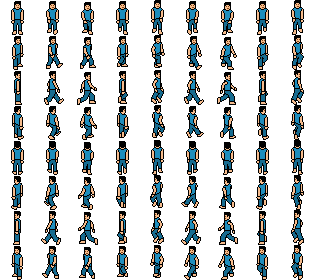
My first spritesheet

Resulting animation
The next step was to see if it actually looked good moving around a surface.

Yes!
I didn't know any game math, but I knew from tutorials that in an isometric perspective, a square is twice as wide as it is tall. So, any movement along the y-axis had to be halved. This made for a very simple isometric transform:
screen_x = x;
screen_y = y*0.5;
Ok, after I got the basics down, It was time for a stress test.
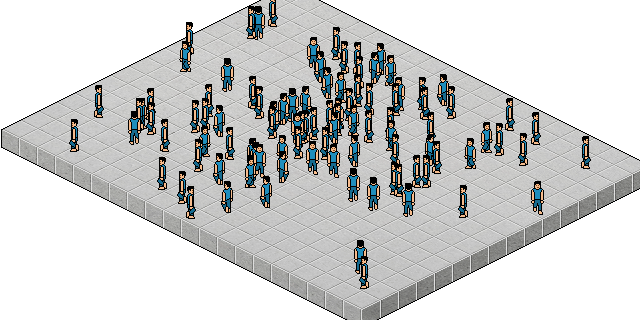
Stress me out
By now I was waking up at 6am and jumping right into the computer to make more sprite sheets. It was intoxicating. Every day I felt a step closer to realizing my dream of making a game.
I did a bunch more tests and I found the fastest way to draw stuff on screen using Flash was to use a method called "copyPixels". The tutorials called it "bitmap blitting" but I only cared that it was super fast. Most flash games those days used Vector graphics - very sharp and smooth shapes. This was a huge burden on CPUs around the world (and eventually led to Flash's demise), but by using copyPixels my game could have way more stuff onscreen than other Flash games.
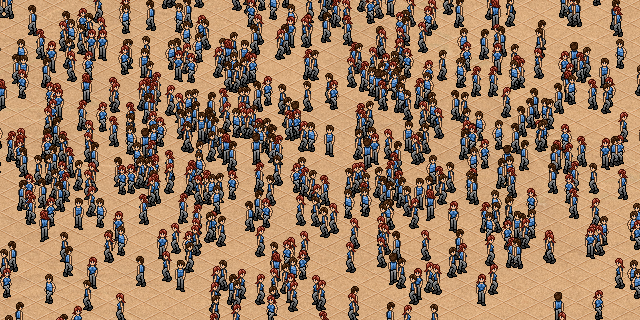
Walk all over me
Ok, the tech looked good, so it was time to start thinking about what kind of game this was going to be. At the time, tower defense was a very popular genre, and I loved RTS games. I decided that the simplest route was to make a bunch of enemies walk in one direction while you try to stop them, with lasers. Taking heavy influence from Starship Troopers and Starcraft, I created a suitable enemy that you could have fun slaughtering by the hundreds.
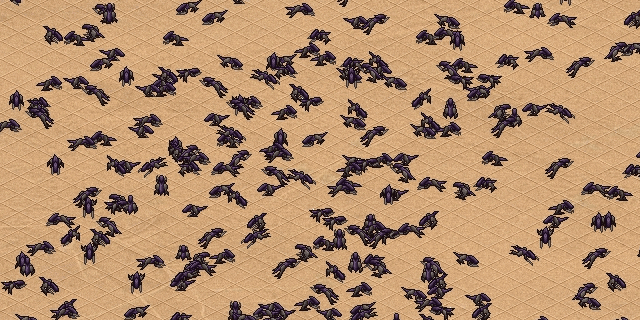
Blizzard dont sue pls
I kept developing the game like this, working on one thing at a time and making sure it was acceptable before moving on to the next thing. If I don't stop myself, I could probably talk about every little detail that went into making the game, but we still have a long way to go.
7 months later...
I had a small but complete game on my hands. I called it "Desert Moon".
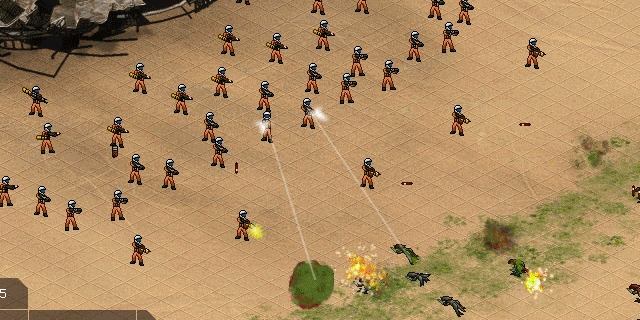
C'mon you apes, you wanna live forever!?
It was time to put the game up for bidding. I uploaded the game to FGL.com and proceeded to not sleep for the next few days. I wish I took more screenshots of this process. I think at the time the bidding period lasted 1 month. After many tens-of-thousands of "reload page" clicks later, there was finally a winning bid. It was 8500 USD! I don't know how to describe how I felt, but my head must have grown very large. I showed my girlfriend and my parents, the latter finally accepting that I wasn't going to grad school.
My girlfriend, Terry, also loved Tower Defense games and she was the main play-tester during development. This was a very happy time for us.
All I had to do was slap the Sponsor's logo onto the game and we could release it to the world.

Thank you business daddy!
The game launched on the major Flash game portals (Kongregate, Newgrounds, Armorgames, etc.) on December 11, 2010, and thus began my gamedev career.
2011 - Indie to Employee
Flash games are free, so once a game is out there's not much you can do to make more money besides make another game. It takes a while before securing a sponsor and the game finally being released so I immediately started on another game called "Solarmax".

First prototype
One of my favorite games of all time is Homeworld. There's just nothing like the epic feeling of the fate of your entire race, your entire history, resting on your shoulders. I couldn't do anything near a 3D RTS like Homeworld, but there was a popular genre of Flash game called "Swarm" defense / strategy. I think Phage Wars was the most popular of these. I thought it would work well translated into epic space battles.
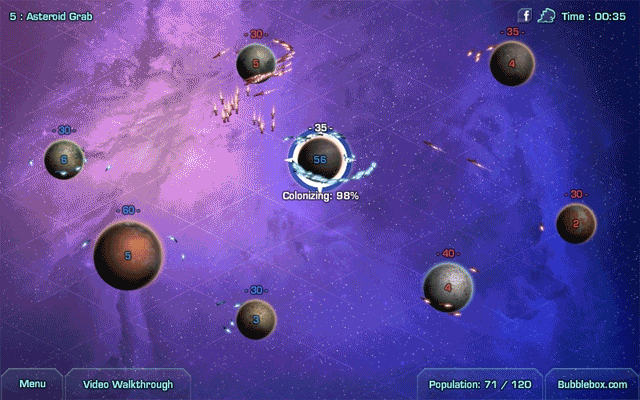
Scientifically accurate depiction of orbital mechanics
I spent some time learning 3D modeling software for this game. I was quite tired of pixel art after doing all the spritesheets for Desert Moon and exporting 3D models as a png sequence seemed like a good way to get all the angles needed for an isometric perspective without having to manually draw every frame.
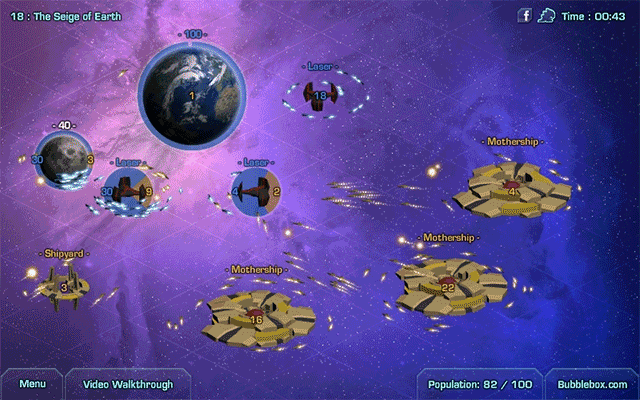
pew pew!
The game was completed in 3 months, much faster than my first project! I was able to get it sponsored for 6000 USD. A bit less than before, but it was a "non-exclusive" sponsorship meaning I could still sell "sitelocked" versions of the game. This was a common practice back then of having 1 version that would spread to all the portals, and many "sitelocked" versions that had a different site's branding but could only be played on their site.
I planned to keep building small games like this as my skills grew, but then something unexpected happened. I got a job!
I got an email from the CEO of a tech company in the U.S. who had seen my games and was looking for a flash programmer for a game they were making. Who knew CEOs were randomly playing flash games and emailing the developer?
My first response was actually to decline the offer, because number 1 - I'm a dunce, and number 2 - I thought I could just make small flash games forever. Luckily this guy was persistent and I would still get to work on Flash games, but with more team members! And and... they were going to fly me out to the States to attend GDC!!!

I'm in GDC!
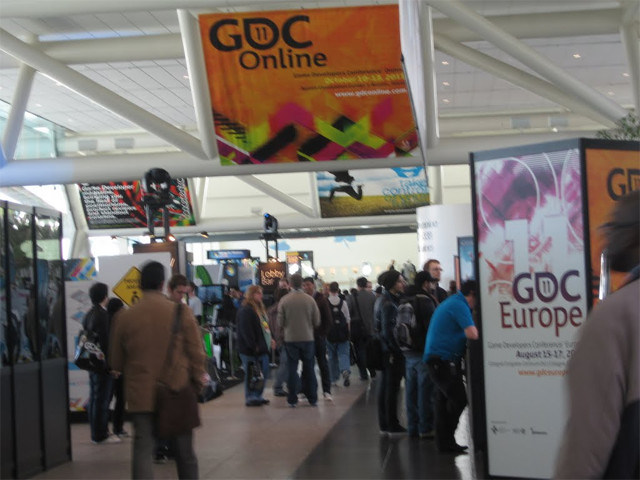
I'm in San Francisco!
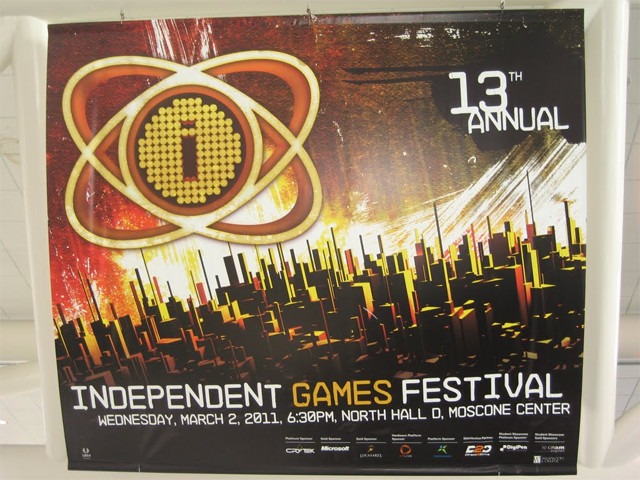
Another time, baby
I'm so grateful to the people who made this happen! As a young game dev, going to GDC is like going to see the Vatican if you're ultra-Catholic. I was over the moon.
Plus, the salary... it was 3000 USD a month! A U.S.-based salary for someone living in the Philippines! I have to tell you, I really thought I was hot shit at the time.
After I got my first paycheck, I proposed to my girlfriend Terry, who I was sure would say yes because the year before her lawyer-auntie cornered me and demanded a deposition on why I had not married her niece yet.
Things were going great!
2012 - Life... finds a way
In January, Terry and I got married! I was imagining that the next few years would be just the two of us, traveling together to different countries... making up for all the times we weren't allowed to travel together because the Philippines is a conservative country and it would be scandalous.

Our wedding Jeepney
Instead, 9 months later we had our first child! Which is great too I guess haha... ha.
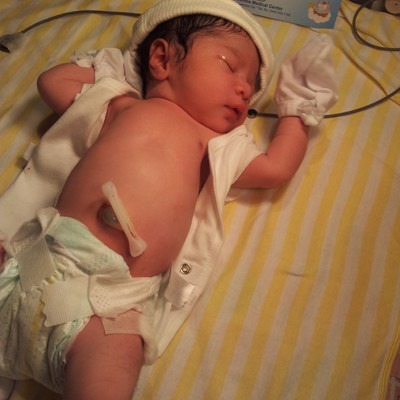
Yup, that's a baby alright
Becoming a dad mostly just means that a full-night's sleep is a thing of the past, at least in the beginning. I was working from home anyway so the arrangement was very doable.
Meanwhile, work as an employee started out great and we produced lots of small games in a short time frame. Over the months though things started to drag. I felt myself becoming less and less productive. I missed the feeling of always learning something new and putting what I learned into a game. Maybe I'm just a bad employee?
To prove how bad of an employee I was, here are some prototypes I made mostly during my free time.
An isometric aerial dogfighting game in a fantasy WW1 setting:
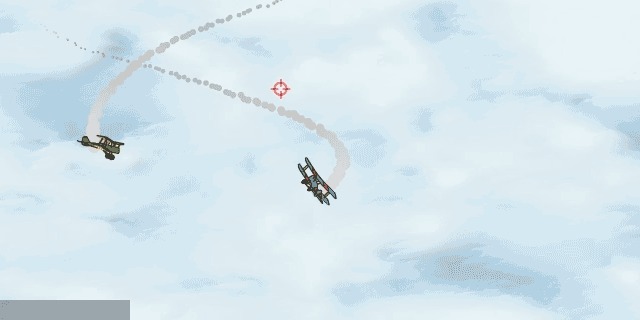
I challenge you to a duel, good sir!
A pixel-ly survival game where you explore a procedurally generated dark forest:
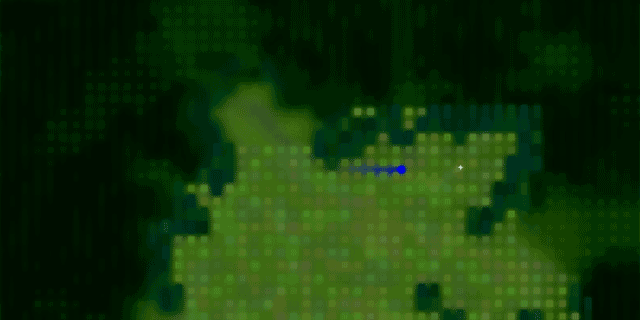
Katniss?
A pixel art zombie defense game:
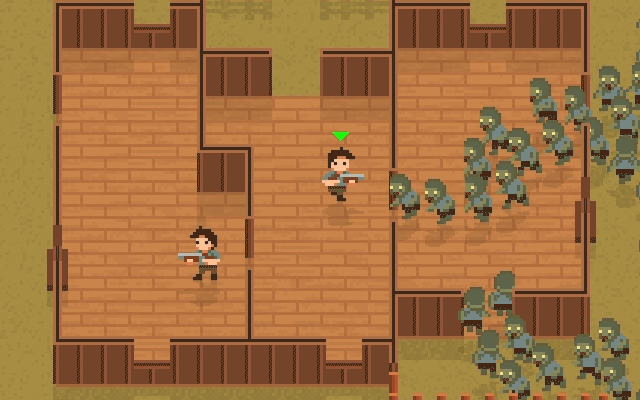
I learned flow-field pathfinding for this!
An early prototype for a 4X space game:
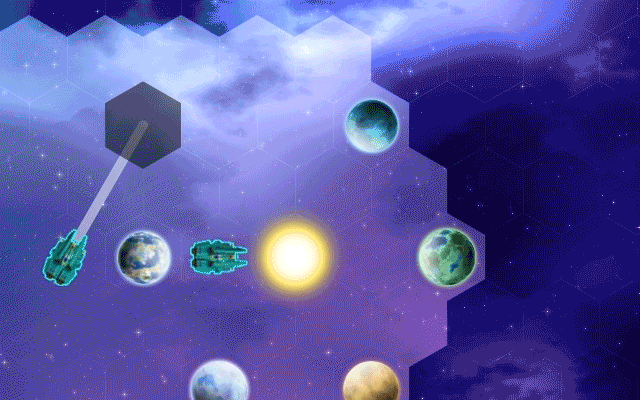
Ambitious much?
A procedural house generator?
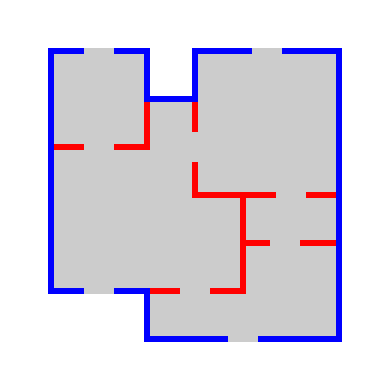
I should probably be working now...
omg I don't even remember what this is, it's freaking me out:

but it was in my files so I must have made it?
I was having fun making small prototypes but I never fleshed out any of them into a full game.
Regular work was different... You have to be on the same page as everybody else so introducing something new creates a bit of disruption. Working from home and barely seeing the team also takes its toll... you don't get to see the team's reaction to your work and you start to feel like your work doesn't really matter.
By the end of the year things had hit a low point for me and I decided to leave the company. I thought that I could start again right where I left off and keep making Flash games. I had a good amount of savings by now and was feeling confident.
Little did I know that the Flash Game market had changed.
2013 - Before Indiepocalypse, there was the Flashopocalypse
On a high with my newfound freedom, the first thing I wanted to do was join the Global Game Jam that happens every January. I had never participated in a game jam before, and I needed a way to shake off the dust. In a game jam, you have 48 hours to make a game based on a theme. The theme this year was the literal sound of a heartbeat. I made this little game called "Heart the Beat".
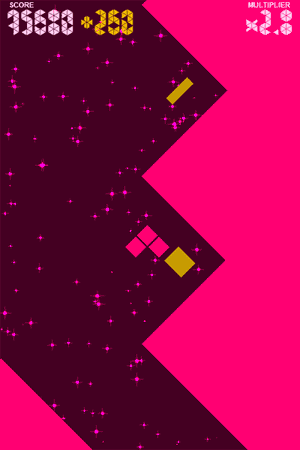
Sorry for the seizure
Finishing the game in 48 hours made me even more confident in my skills. I was ready to take on even bigger challenges!
From a technology standpoint, Flash had grown a lot in the past 3 years. Instead of bringing CPUs to their knees, it was now possible for Flash to use the Graphics Card with a new API called "Stage3D". This was super exciting for me. 3D games were now a possibility!
So, naturally, I tried to make Homeworld again.
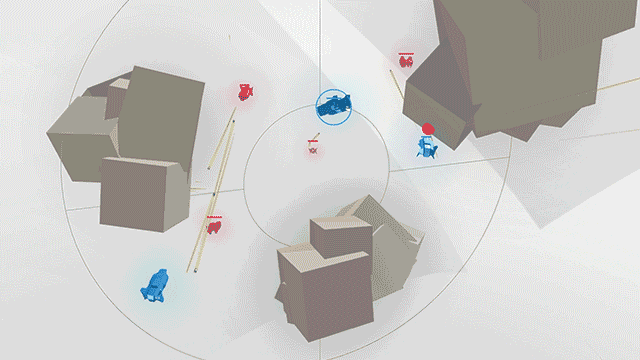
I used Blue Danube Waltz as the background music
But I didn't get very far... after 3 months I got stuck. Sure I had little ships shooting missiles at each other and blasting each other with lasers, but I realized those are only small parts of what makes a great game. What about the atmosphere? The backstory? The motivation for the journey?
I got too ambitious, and ended up feeling paralyzed. I decided the best course of action was to cut my losses and release the game for free.
To get back a bit of confidence, I joined another 48-hr game jam called Ludum Dare, which happens 3 times a year. It's the biggest online game jam community and it's really fun! Participants get to vote on the theme before the jam starts. I really wanted the theme to be "Potatoes", but the winning theme turned out to be "Minimalism". Feeling robbed, I made a game about Potatoes beating up Minimalists.
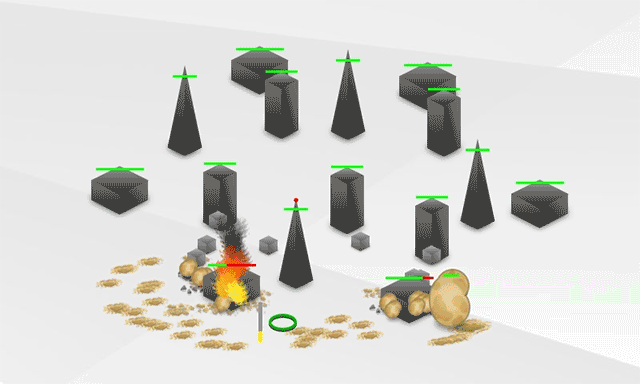
"Taterush", 2013
Ludum Dare has a brilliant rating system where the more you play and give feedback to other people's games, the more your game gets played and the more feedback you get. It's a really effective way to improve your skills and interact with other developers.
I joined Ludum Dare 2 more times that year. I made a trippy neon shooter...
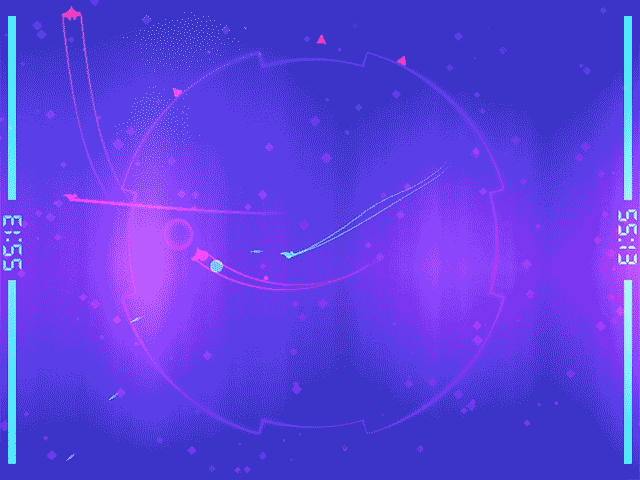
"Cyanocide"
And a silly little game where you play as a tiny ninja slashing other tiny ninjas...

"Dojo of Death"
Which to my complete surprise, become my most played game... ever. To this very day. I'm serious. Millions of people played it. It even got covered by Kotaku and Rock Paper Shotgun. Despite the popularity, I think I only ever made about 500 USD from sites like Kongregate that would share a bit of the Ad revenue with you.
As much fun as joining game jams were, I realized my savings were running out faster than I expected. I estimated that I had about 4 - 5 months of savings left.
Feeling a bit panicked, I decided to stick to my comfort zone - a 2D strategy game set in space!
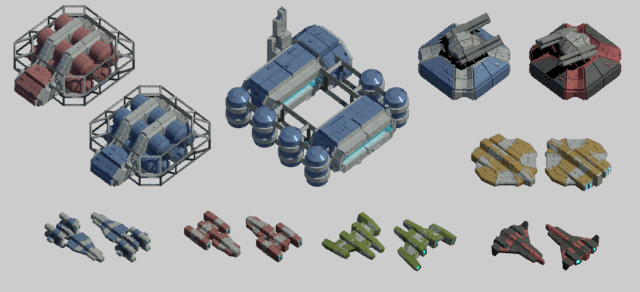
3D rendered structures and units
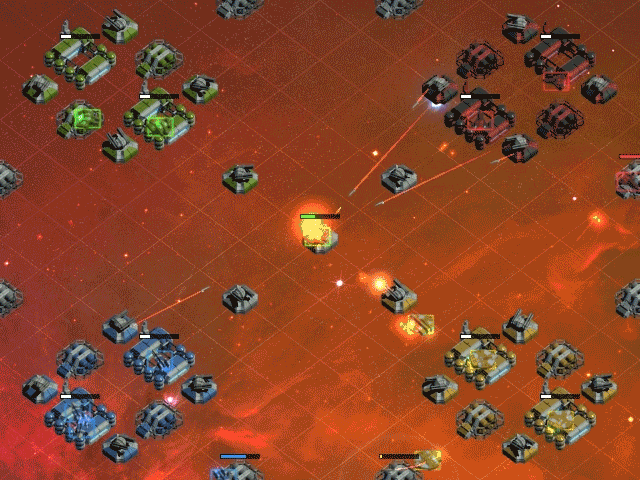
Space battle!
This game was called "Spiral Drive" (not my most creative title). I spent three hectic months working on it. It's like a simplified RTS game. You use little ships to capture shipyards that automatically produce more ships, and the goal is to capture all structures on the map. Enemy factions would be trying to do the same.
With Flash's new Stage3D API, the game could run at 60fps and it worked on iPhone and Android phones. I was sure the game would fetch a good price!
But things had changed since I was last on FGL. A mobile version was actually expected by default, and sponsors were putting up less money for Flash games because advertising revenue had dropped off for them as well. Bids were coming in slow and low...
In the end, the highest offer was 5000 USD for the web version and included publishing rights for the mobile versions. I was disappointed, but it was better than nothing.
The deal included a 50-50 revenue split for the mobile versions, so I had my hopes up that the game would produce a little more income. Unfortunately, and I hate to sound bitter, but the publisher really botched the mobile launch. On launch day, we were looking for the game but couldn't find it. It turned out that the publisher had uploaded the game under the name "Sprial Drive", instead of "Spiral Drive". I mean, I can see how easy a mistake it would be to make and I guess it's my fault too for not thinking about the title more, but the end result was that the game got buried in the app stores and produced almost no revenue.
Things were not going as I had planned. It was clear that I could no longer rely on FGL to provide a steady income.
2014 - Moving to Mobile
Early in the year we welcomed our second child into the world!
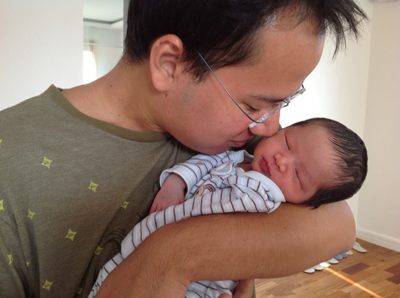
baby #2
As a side note, Babies smell really good. Don't have babies just to smell them though. Borrow someone else's and smell them if you must, just be sure to give them back.
With our growing family, I felt a great sense of responsibility to increase our income. Flash games were decreasing in popularity as people moved on to mobile. It was clear that we would have to move to mobile as well.
Over the years I received a lot of requests to do a sequel for Solarmax. Now, I don't usually do sequels because in the process of developing a game, you will have played it thousands of times and become quite sick of it. It's much more exciting to work on new ideas, but with my savings dwindling I was feeling a bit desperate.
For Solarmax 2 I focused on having a very clean and readable UI. The game had to be playable on a multitude of screens, from tiny phones to a full desktop. Terry, who loved this style of game, play-tested the game to death. The game took 5-6 months to finish.
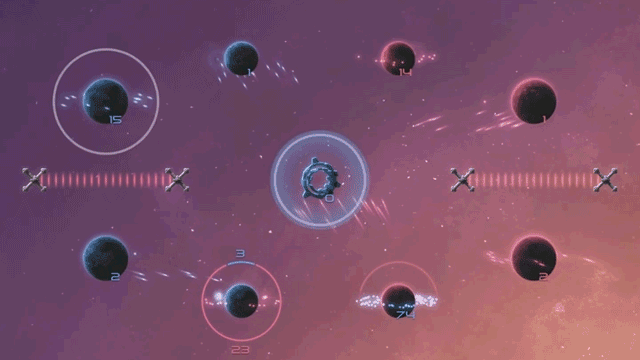
it turned out quite beautiful
Not wanting to deal with a publisher again, we decided to publish the game ourselves. The plan was to launch the game for free on Flash portals, and have a button on the game linking to the iOS, Android, and Desktop versions, which were paid. We were hoping the initial surge of players from the flash portals would place the game on the iOS and Android charts, which would then drive even more sales.
With trembling fingers, we launched the game on June 7, 2014... to an initially disastrous reception.
On the flash portals, players could rate your game from 1 - 5 stars, and only games rated 3.5 - 4.0 or higher could make it to the front page. Getting the game onto the front page was vitally important - it was the difference between a few hundred plays and hundreds of thousands. We were relying on the traffic from the flash portals to drive sales for the mobile versions.
A few hours after launch, the game's score was 2.7... I remember just laying down, trying not to cry. Then I read the comments. Some people were getting really frustrated at the game's difficulty and control scheme. It was something I could fix. With encouragement from Terry, I spent a few frenzied hours adding additional difficulty modes and made changes to the control scheme. After updating the game, Terry and I tried to message everyone who left a negative review, asking them to give the game another try with the new modifications.
It paid off. The game's score slowly crept up, ultimately settling around the 3.7 - 3.9 range. The game made it onto the front page of many Flash portals, and a few days later started appearing in the "Best New Games" lists of the Apple and Android stores.
In the first 2 months, the game made over 11,000 USD, split almost evenly between the Apple and Android stores.

Apple App Store ~ 5500 USD

Google Play store ~ 6000 USD
It would go on to make over 20,000 USD by the end of the year.
The smart thing to do at this point was to try and duplicate this success with another mobile game, and launch it using everything we learned during the process.
I wish I did that.
Flash and Mobile games were always just stepping stones to me. In my heart of hearts, I knew I would not be satisfied until I could recreate the games of my childhood - the PC games that used to occupy all my time and thoughts.
I joined a contest for making RPGs. Unfortunately, I found out about it late and had only two weeks before the deadline. I scrambled to put together a prototype, inspired by the art style of a popular iOS game, Monument Valley:
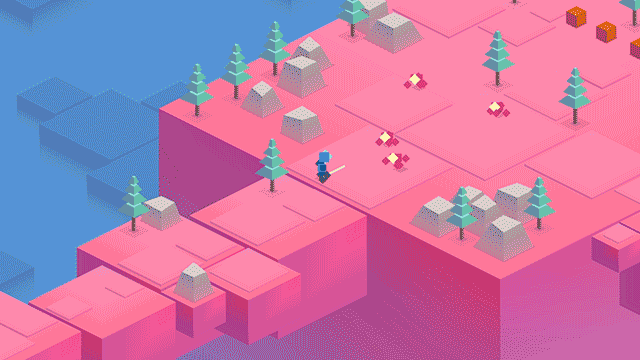
looks delicious somehow
I wasn't able to finish it before the deadline, but In my rush I developed a new technique to render isometric characters. Instead of using a sprite sheet that had an image for every possible angle, I used a group of 3D points to represent the bones and joints of a character, and then drew over them with 2D shapes.
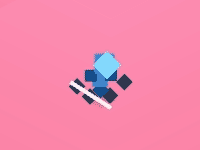
It's 3D... in 2D!
Each joint had an X, Y, and Z coordinate. I would animate them and convert the 3D coordinates into 2D screen-space coordinates, using this formula:
screen_x = x - y;
screen_y = (x + y)*0.5 + z*1.23;
Because of the crunch the game's code was a mess. The contest was over anyway so I tried to salvage what I could and made another prototype, this time inspired by "Frozen Synapse", a game where you try to eliminate the other team with superior tactics and guns.
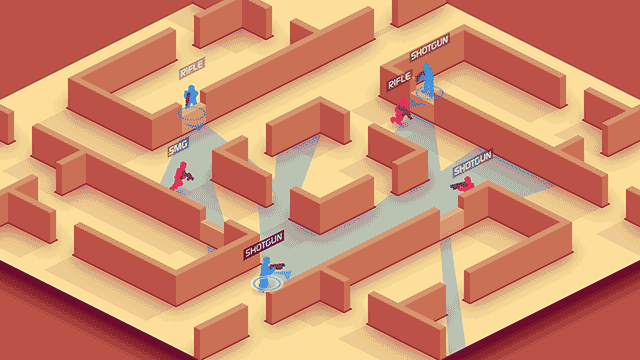
"Matrix" music playing
This prototype looked promising, and I kept advancing my character rendering and animation technology.
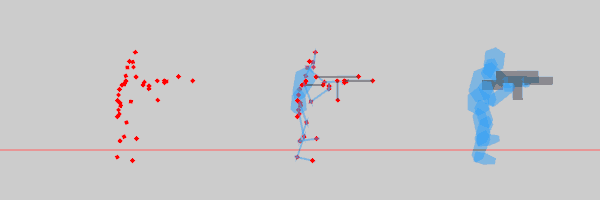
Bones were now connected with hexagon shapes
Unfortunately, like "Spatial" before it, I got stuck and couldn't finish. I released the game for free.
My problem was that I was good at prototyping game mechanics, but I was getting stuck at creating content that would fill out an entire game. All my prototypes felt like "tech demos" instead of fully fleshed out games.
But what else can you do except make more prototypes? You never know when the next one will pan out into a full game.
The next thing I tried was a stealth-action game with Tron-like visuals.
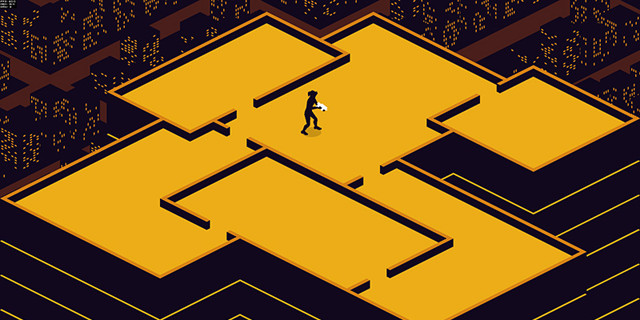
first pass

put some purple in it
This looked interesting, but I couldn't get the stealth mechanics to feel fun. I dropped the stealth and made it a straight action game. I took inspiration from one of the most popular 2D action games at the time, "Hotline Miami".
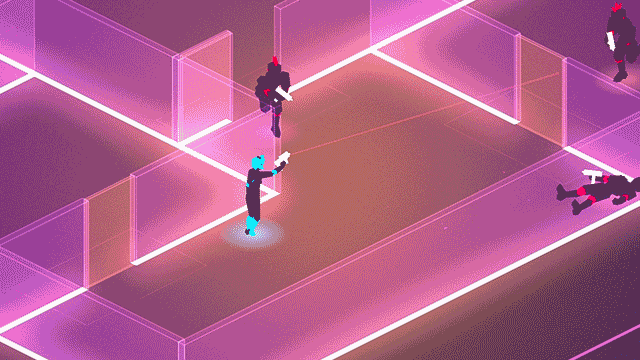
Feeling lucky, punk?
The game felt fun! It had a fairly unique visual style... I felt like I hit on something good. I gave the game a title - "Lithium City".

I'm smelling lithium now
This felt like a game I could finish, and one that could break into the PC game scene.
I planned to spend no more than 6 months in development, which up to this point is how long my projects usually took.
I never expected that this game would come to dominate my life for the rest of the decade.
2015 - Honeymoon
I could handle the art, programming, and overall game design, but to compete with the likes of Hotline Miami, the game needed a really good soundtrack. I took the game to my younger brother, John Camara, an exceptionally talented composer and audio engineer that no one knows about yet.
John had previously made the soundtrack for Solarmax 2, and was instrumental to that game's success. A lot of people looked up the game's OST after playing it.
We set to work. I worked on adding levels, weapons, and enemies, while John worked on the game's audio and music.
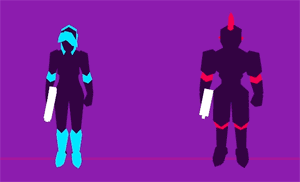
more detailed characters
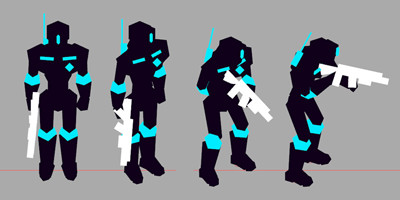
more robot-like characters
One thing that was still difficult to do was character animations, especially the death animations which needed a lot of variety to prevent the game from looking repetitive. I found it was easier just to make enemies explode on death and throw out lots of particles.
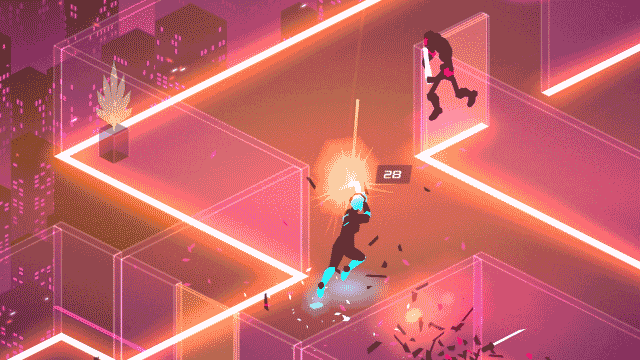
Death animations are hard, just make em explode
There were lots of problems with making a shooter in the isometric perspective, but we were able to solve most of them.
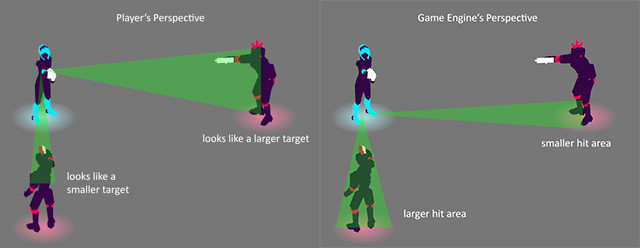
problems with the isometric perspective
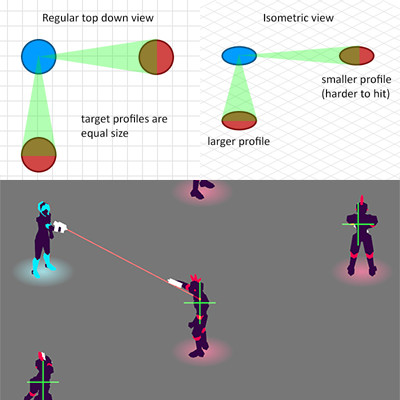
solution: custom cross-shaped hit areas
At some point, I got derailed and wanted to change the art style from glowing neon rooms to realistically lit pre-rendered rooms:
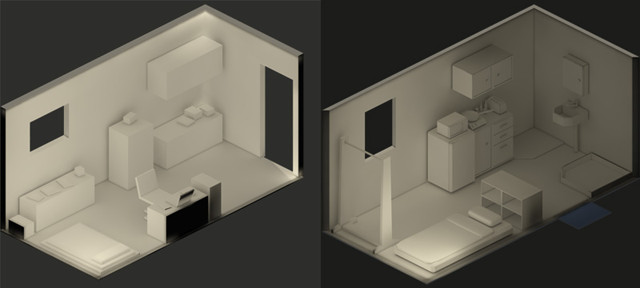
drafts
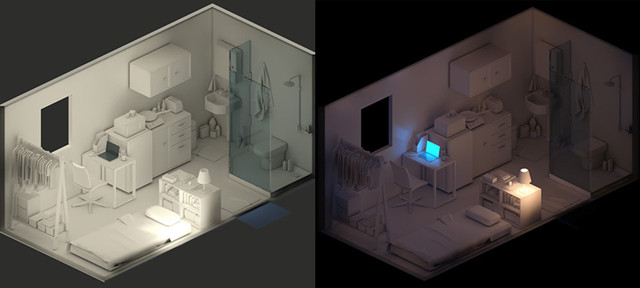
finals
But this took over a week just to do one small room! I went back to the original art style. It was much faster to create levels in this simplified, stylized version.
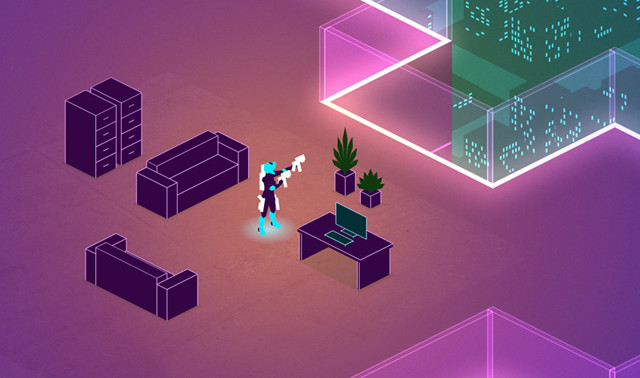
testing furniture
Another issue was how to create the game levels. We didn't have a map editor, so I used Photoshop to create the game's levels in pixel art. An algorithm would then scan the image pixel by pixel and look for particular shapes and colors of pixels, and then create all the walls, furniture, doors, and other game objects.
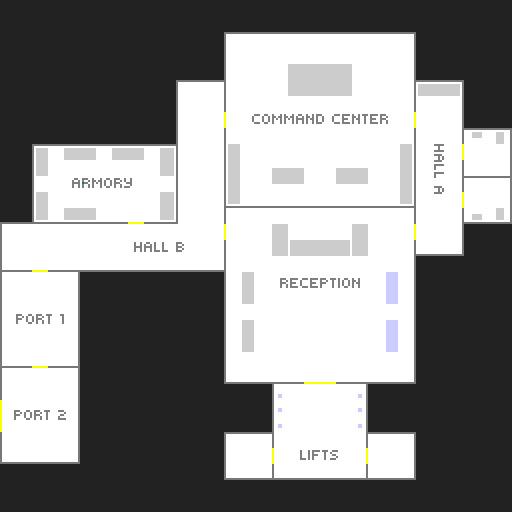
map created in pixel art
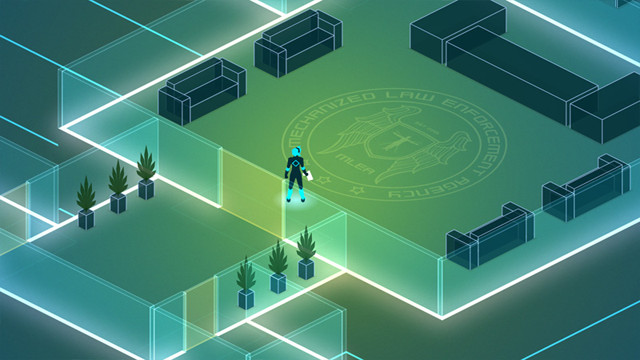
"Parsed" into a game level
The game was slowly taking shape. We were getting excited and wanted to show off our work to the world. We started thinking about how to spread awareness about the game.
As part of the marketing effort, we submitted the game to GDC China's Independent Games Festival, or IGF.
To our great excitement, we made it in! The game was selected as a finalist, which meant we would be flying to Shanghai to exhibit the game at GDC China!

packed room!
It was very nerve-wracking to finally put the game in front of players, but the feedback we got was very positive! It was also very useful to actually watch players play your game. You could see exactly which areas you had to improve on.
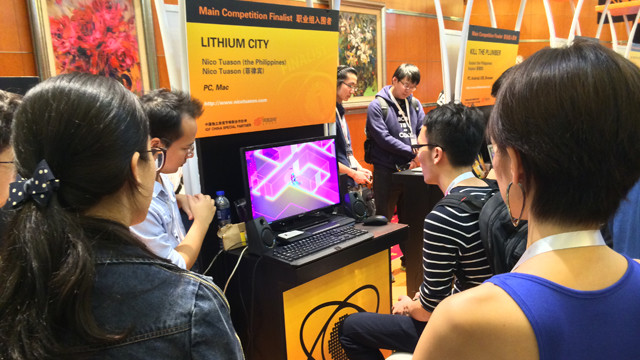
First public appearance
To cap off this wonderful experience, John's music won an award! The game took home the IGF's "Excellence in Audio" award. John went up on stage to accept it, and was so overwhelmed that he started crying. I gave him a big hug afterwards.
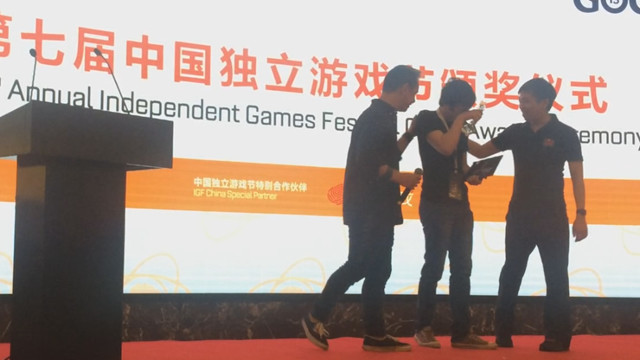
You deserve it bro!
It seemed like we were on the right path. All we had to do was finish the game.
2016 - Convention Crazy
A few days before Valentine's day we had our third child!

This woman... is so much more productive than me
By now you might be wondering how many children we were planning to have. Well, both Terry and I came from large families with 5 children each. We felt that growing up with a lot of siblings was a big part of growing up Filipino. Plus, there are a lot of advantages - the kids always have a playmate, they learn socialization and negotiation early, and birthday parties are always these huge, raucous affairs.
Also... uh economies of scale? Having 1 child is a huge shift in lifestyle, but having more children lets you take advantage of the changes you've already made. It makes more sense to buy a crib and an electric breast pump if you get to use it multiple times right?
Okay, that's actually a lame reason. But seeing the children play with each other and grow up together is a special kind of happiness.
Meanwhile, back in the world of gamedev, I received an email with a startling offer...
A fairly large company offered to buy the entire IP (Intellectual Property) of "Solarmax". This meant that they would own Solarmax 1 and 2, the right to make future sequels, the desktop and mobile versions... basically everything that had to do with the game.
Feeling conflicted, and not really wanting to go through the trouble of an IP transfer, we threw out a number that was much higher than the total amount of money that the game had made so far. But after a quick negotiation, they agreed.
I can't disclose the exact amount, but I estimated it was enough to pay for our living expenses and the development of Lithium City for 2-3 years. I wasn't sure if I would ever make another Solarmax game again, and I felt they might do a better job and take the game in new directions. It was an offer I couldn't refuse.
So, what's the first thing you do when you receive a huge sum of money?
Spend it on going to Game Conventions of course! (Spoilers: this is a bad idea)
Part of the prize for winning Excellence in Audio at IGF China was 2 all-access passes to the main GDC in San Francisco. The all-access passes were worth a lot, but we would have to get our own plane ticket and lodgings. Still, energy was high and it seemed like a good idea at the time. Besides, I wanted John to experience that same thing I felt the first time I arrived in GDC.
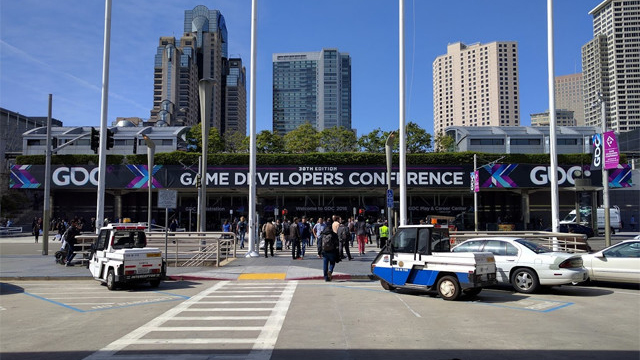
I'm back
Wanting to build up hype around the game, we signed up for a few more conventions. These included G-star in Busan, South Korea:

Thank you for letting us share your booth, Department of Trade and Industry!
Tokyo Game Show in Chiba, Japan:
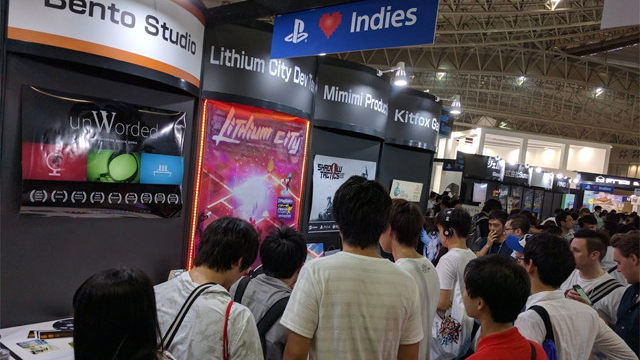
Sony put up many booths for the Indie Showcase
Casual Connect in Singapore:

I forgot to take photos... but we saw this rad-ass Jellyfish at the aquarium
a local convention in Manila called ESGS (E-Sports and Gaming Summit):
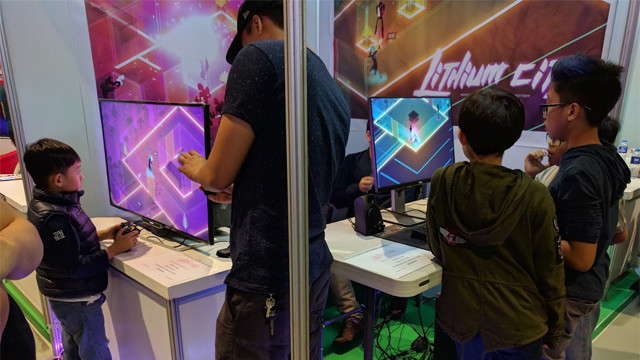
Kids loved it
and even a small university event:
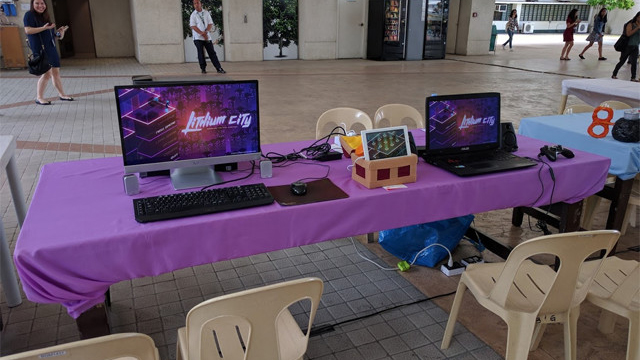
One student said, "Ya this game is cool I'm totally gonna pirate it dude".
In hindsight, as much as an adventure taking the game to conventions was, it was absolutely not the best thing we could have done to finish the game.
When you know you have a convention coming up, you try to tailor the game to stand out during the exhibit - this means getting to the action quickly and introducing new mechanics often to keep the game exciting to play... at least for a short time.
As you would have guessed, the costs of travelling were adding up and we were burning money very quickly. At this rate, instead of having enough for 2 - 3 years we would run out of money by next year.
So, we stopped signing up for conventions and hunkered down to finish the game.
Far from the excitement of convention-going, real game development is time-consuming, often tedious work. An old problem reared its ugly head... I couldn't create enough content to last a full game. I had gotten so used to starting projects and abandoning them, that I wasn't sure I knew how to finish a game anymore. Things dragged on.
2017 - The Fall
Our growing family's expenses were piling up. There's diapers, milk, food, preschool, trips to the doctor... a never ending list of necessities.
The money ran out in March, and the game was not finished.
I always thought that when the money started to run out, I would instinctively go into a hyper-productive mode to finish the game, like cramming a paper before its due date. This isn't what happened. Deadlines came and went... I had an inner critic that kept telling me if I launched the game now, all those people we had shown it to would be disappointed.
We spent the last year going around the world telling people what an awesome game this was... it couldn't be anything less than awesome.
To buy more time, I did something that I am embarrassed to admit. I ran back to my mommy and daddy.
Yup, at 30 years old I asked my parents for money to pay for our living expenses. I promised that I only needed another 6 months and that I would pay them back.
Terry was also making a living as a resourceful entrepreneur, so we could maintain our lifestyle for now. I took on more of a house-husband role.
I knew my problem was that the game lacked content, so I turned to procedural generation to fill out the game's length.

save me, algorithms!
The game's visuals improved a lot during this time. Terry, who was taking a course in Interior Design, directed me in designing the furniture and making the interior levels look less empty.
I had different algorithms for different levels:
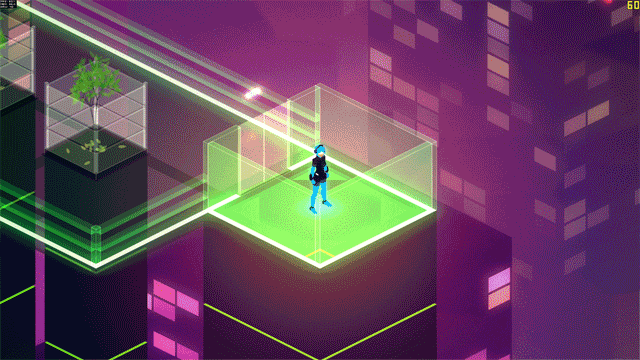
Level was bad? Not my fault, the computer did it
If you've ever played a game with procedural generation, then you are aware of the problems. It's not a silver bullet... the levels might look superficially different, but the play experience is the same every time. Procedural generation wasn't increasing the game's length, it was making it boring.
I scrapped the procedural generation prototypes and went back to designing hand-crafted levels. This time, I thought the right move was adding a story with characters and dialogue.
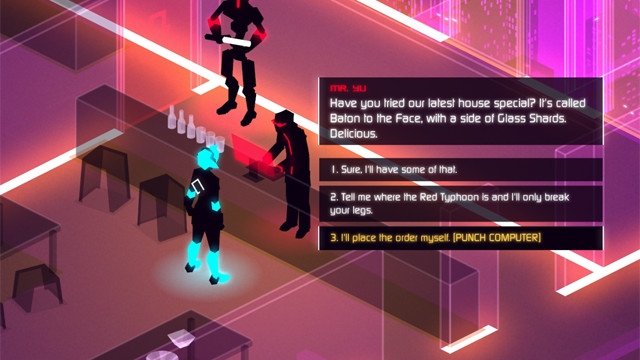
With dialogue options even
It turns out I'm not good at writing. Every time I would write a bit of dialogue, I would be so embarrassed to read it the next day and deleted it.
Trying and failing so many times was taking its toll. Every time I did something that didn't work, it would take longer to build up the energy to try something new.
Instead of working, I found myself doing things that made me feel like I was making progress without actually working on the game.
These activities included:
- Watching game design and analysis videos on Youtube
- Reading marketing articles on Gamasutra and gamedev.net
- Buying every new Indie game that seemed successful, trying to see how they did it.
- Replaying classic games hoping to get ideas for game mechanics
- Reading books about story-writing hoping to become a writer overnight
- Checking out other game's development blogs and screenshots
- Playing a 250-hour long RPG to "refresh your mind" and rediscover your love for gaming
- Starting a smaller game that "We'll finish in 1 month and launch to provide some income".
- Reading stories on Reddit about other people's game development experiences.
I promised my parents that I would only borrow money for 6 months and it would be enough to finish the game. It wasn't.
In October, our 4th child was born:
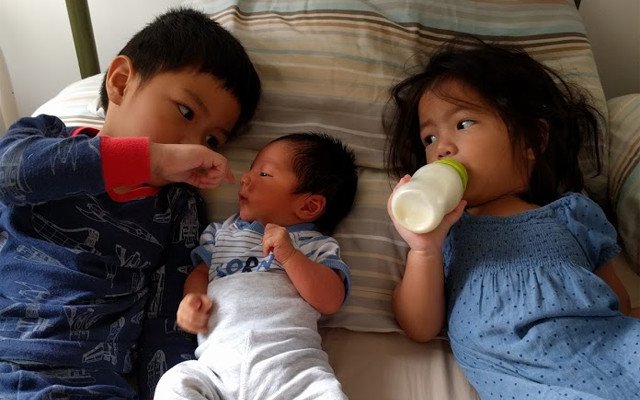
Haha, I'm in danger
2018 - The Valley of Despair
When they say "Valley of Despair", they make it sound like it's just one low point you have to get through, and then things start going uphill. This is wrong. It should really be called the "Dark Labyrinth of Despair". You can't see the way out, and you have no idea how long you will be wandering, running into dead ends, with no guarantee that you will ever find the exit.
Despite missing my deadline, my parents never stopped sending me money to pay for living expenses. I felt like a failure. I felt that everything I had accomplished up to this point meant nothing because I was still living off my parents and my wife like a freeloader.
Still, just because you feel like shit inside doesn't mean you can stop being a dad and a husband. My game development career was in the dumps, but my life was still full of happy moments with my family. I don't know if I would have survived this time without them.
The kids were growing up. Our eldest started elementary school, which over here starts at 7:30 AM. Carefree mornings were replaced with a rigid schedule of shower, breakfast, preparing packed lunches, and driving the kids to school.
Whenever I tried to work on the game, I would just end up discouraged and drained of energy. I couldn't stand the feeling of being unproductive, so I felt compelled to be productive in other areas of my life.
I took up baking. It was such a refreshing change from game development... You follow the recipe, pay attention to the details, iterate on the work, and you are guaranteed a reward - something delicious that you could share with others and make them happy.

Japanese Cheesecake
I'm sorry I know this is supposed to be about game development, but I just have to get this out of my system. I spent 3 months trying to recreate the Portuguese / Hong Kong Egg Tart. The hardest part of this was creating the puff-pastry, which took at least 2 days to make per batch.
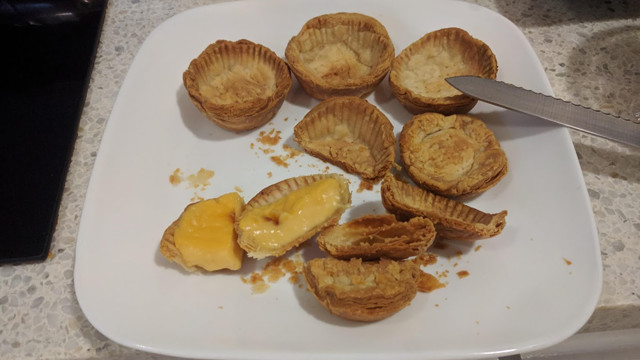
First prototype
The trick with puff pastry is that you have to keep it ice cold while rolling and folding the dough. The ambient temperature where I lived was 30-33 degrees Celsius - impossible to work with. I found a solution by shoving a table right under an air-conditioner and putting the thing on full-blast, folding the dough under the finger-numbing cold.

after 3 months of development
It's not traditional, but my version is doable without a 400 degree Celsius oven that industrial bakeries use. Here is the recipe I developed:
Nico's Egg Tarts
Dough:
250 grams all-purpose flour
100 grams water
7 grams salt
40 grams butter (82% fat or higher, softened)
Butter block:
160 grams butter (82% fat or higher)
Vanilla Custard:
5 large egg yolks
250 grams whole milk
250 grams heavy/whipping/double cream
100 grams white sugar
30 grams corn starch
4 grams vanilla extract
2 grams salt
Tools:
Rolling pin
Parchment paper
2 cupcake / Muffin tins
cookie cutter (1+ inch wider than muffin tin holes)
paper cupcake liners / 24 metal cupcake molds
silicone spatula
piping bags
kitchen blowtorch (for the burnt custard top)
Procedure:
1. Combine the flour, water, salt, and softened butter to form a rough dough. Knead for 5 - 10 mins until completely combined. Cover in plastic wrap and chill for 2 hours.
2. Fold parchment paper into a squarish shape that can encase the butter block. Use a rolling pin to flatten the butter block until it forms into the shape of the parchment paper and is about 1/4 inch thick. Chill butter block for 1 hour.
3. Flatten the chilled dough into a rectangle shape twice the length of the butter block. Take the butter block out of the parchment and place it on one end of the dough. Pull the other end of the dough over the butter to sandwich it, covering the butter completely.
4. Dust the dough and your surface well with flour. Using a rolling pin, roll the dough out in one direction until its length more than doubles. Fold the dough over itself in three segments, like a letter.
5. Repeat step 4 3 more times, making sure the dough stays chilled. If the dough starts to warm up and become soft, or the butter looks like it's melting, wrap it and chill in the fridge for 1 hour before continuing. If butter breaks through the dough, dust with more flour and keep going.
6. Cut the dough in half. Store one half in the fridge. Roll the other half out into a big square / rectangle. Using the cookie cutter, try to punch out 10-12 discs. Store the discs in the fridge and do the same with the other half of the dough, for a total of 20-24 discs.
7. Preheat oven to 220 Celsius. Position the discs onto two muffin tins. Lightly and evenly push them into the holes, forming a cup. Place a cupcake liner on top of each disc. Metal liners produce a better shape, but they must be smaller than the holes of the muffin tin. Fill each cupcake liner with uncooked rice / beans / baking weights, careful not to spill onto the dough. Bake for 22 minutes.
8. Pull out the muffin tins and carefully remove the weighted cupcake liners. Either freeze the pre-baked tart shells now, or continue by putting the muffin tins back in the oven for another 5 minutes until the tart shells are golden brown. If frozen, bake for 10 - 14 minutes until golden brown. Let the tart shells cool on a wire rack.
9. Prepare the Vanilla custard by combining the sugar, salt, and corn starch in a saucepan. Mix with a spatula until no clumps remain. Add the 5 egg yolks to the saucepan and mix briskly until egg yolks turn a lighter color. Add the milk, heavy cream, and vanilla and mix thoroughly.
10. On the stove, heat the saucepan on low-medium heat while stirring with the spatula. As the custard thickens, scrape the bottom to prevent burning. Once the custard starts to bubble, cook for 1 more minute while scraping the bottom and then turn off the heat.
11. Transfer the custard to a large bowl. Cover with plastic wrap, making contact with the custard to minimize air exposure. Let cool.
12. Mix the cooled custard with a spatula until creamy again. Fill up a large piping bag and cut the tip so that the hole is about an inch wide. Carefully pipe the custard onto the tart shells.
13. Using a blowtorch, torch the tops of the custard until a nice pattern appears on top. Careful not to torch the tart shell, it will burn easily.
Best served same day. Enjoy warm or chilled. Do not freeze, custard will separate upon thawing.
We would also bake and decorate birthday cakes for the kids. Terry became amazingly good at making marshmallow fondant decorations:
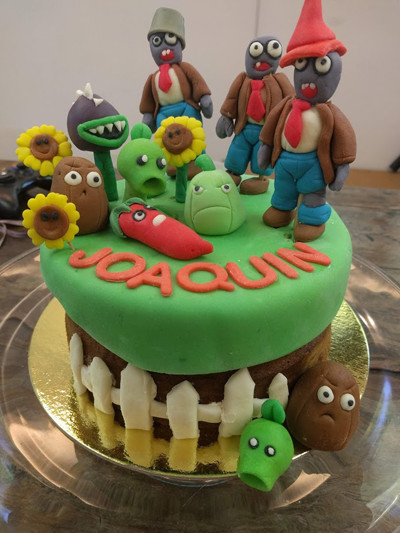
Look at this masterpiece
I was dimly aware that I was running away from a problem... but I just couldn't bring myself to face it. I barely turned on my computer during this time except to watch video tutorials of baking recipes.
2019 - Paying the Piper
In early February, our 5th child was born:

a baby girl
A few days later, she developed an infection near the umbilical cord stump. She had a fever, and the doctor was worried it would lead to sepsis. She had to be confined in the Neonatal Intensive Care Unit, or NICU. Terry and I stayed with her, taking turns holding her and comforting her when the relatively large IV needle (compared to her tiny body) caused her discomfort. She needed antibiotics and constant monitoring. Being a newborn, she would sometimes flail her limbs which caused the IV to become dislodged, necessitating another painful insertion. We were in the NICU for 10 days.
We couldn't afford the hospital bill... I asked my parents for more money. They paid for it. I had passed on the problem to them, because I wasn't responsible with my money when I had it.
I was disgusted with myself. I saw myself as a financial burden to my loved ones. This couldn't go on.
I frantically searched for a job online, but in 2019 no one was looking for a flash game developer. The local game development industry was a BPO (Business Process Outsourcing) industry, with salaries starting low and very little opportunities for advancement. It was a waste of time.
I opened up the Lithium City project files, which I hadn't touched in months.
The person I was... couldn't finish this game. I had to become someone else.
I set my alarm for 4:30 AM. I needed the time to shower, get dressed like I was going to work, cook breakfast, and prepare the kid's packed lunches. The school-age kids would have breakfast at 6:00 AM, and we had to leave for school by 6:45 AM. There was a coffee shop nearby that opened at 7:30 AM. There I would work until at least 12 noon, sometimes extending until 2 PM. The coffee shop had no WiFi, which was perfect for me. I didn't want any distractions.
Working at a coffee shop isn't free, like working from home is, but the level of productivity is different. At home, I was an unproductive slob, but in the coffee shop, dressed for work, I felt like a professional and acted like it. I always ordered hot tea, no milk or sugar, which cost 120 pesos, or 2.4 USD.
When I got home, I would keep my laptop in its bag, and spend my afternoons either doing body-weight exercises, preparing dinner, or baking something for the kids.
I researched what kind of diet would increase my productivity and keep my energy high throughout the day. I learned that sugar was the enemy, and worked to cut it completely from my diet. Breakfast would be a bowl of rolled oats with two eggs, black coffee. Lunch was often a sweet potato with another egg and some fruits. Dinner would be high in protein - chicken, pork, legumes, lots of vegetables. Any grains had to be whole grains, like brown rice or whole wheat bread. I lost around 15 pounds during this period.
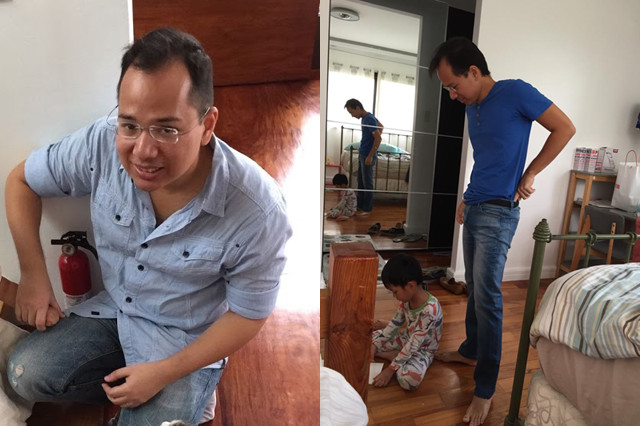
thicc boi to skinny boi
Crucially, I swore off Youtube and Reddit, my biggest time wasters, until the game was finished. I figured I had already lost many years of my life to these sites, and I wasn't missing anything because they would always be there, even years from now. I also stopped playing games. The only game I should be concerned about was my own.
These life changes were starting to make a difference. Because of the set amount of time I had to work in the morning, I found myself actually creating content. I took an attitude of "Doing something, anything, is better than nothing. I can always change it later when I've thought of something better".
The new content was darker... maybe to reflect my state of mind.
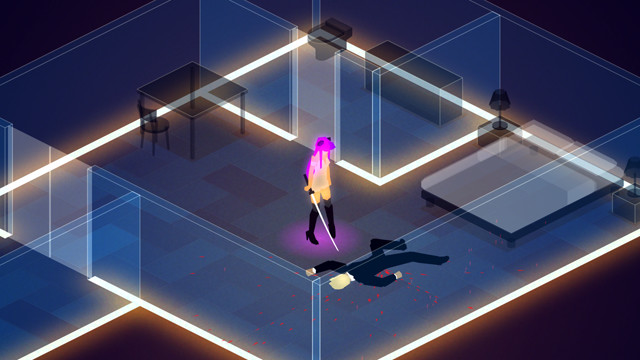
you wake up in a small dark room, a dead body at your feet
But it was working. I was adding content to the game at a steady pace.
I started using guerilla tactics against the problem of creating content. Hit and run. If a problem was too hard, run away from it and attack someplace else. Keep moving and don’t stay in one place too long. Getting bogged down meant defeat.
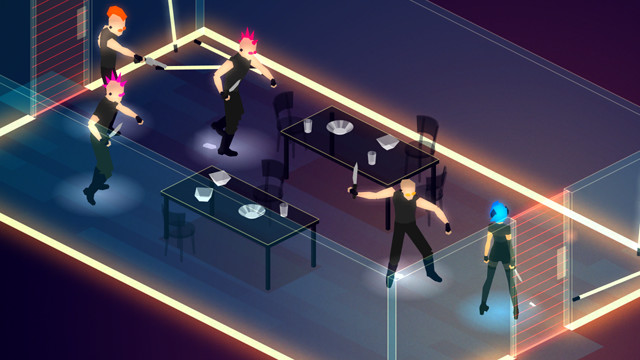
4 against 1? This seems unfair... you should have brought more men
Everything has a cost. The intense attitude I had taken to work was seeping into my attitude at home. Terry and I never had major arguments in the 7 years we've been married, but we started to have them now. It's never fun to be arguing with your spouse, but I told myself this game wouldn't last forever. Every day, I was getting closer to vanquishing the beast.
I stopped trying to plan out the game, and just made content that felt natural based on the previous day's work. Nothing was sacred. If it didn't work, I threw it out and started again.
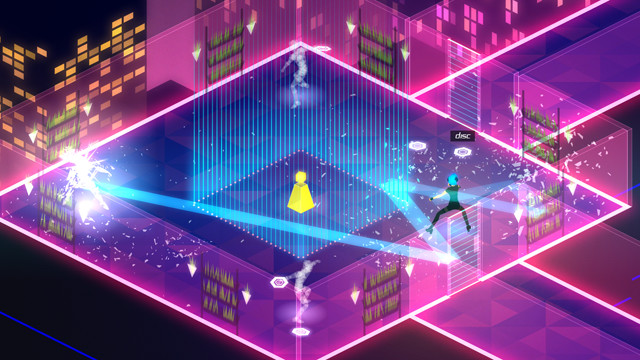
Catch!
In this way, I had completed 6 chapters + a prologue by the end of the year. I planned for the game to have 13 chapters before it was done, but the world had other plans.
2020 - This is it, the Apocalypse
On January 12, a volcano 25 kilometres from where we lived exploded. It sent a column of ash 1500 kilometres high that blanketed all the surrounding towns, including our home.

Taal volcano, January 12 2020
Thankfully, our home had a sturdy roof and walls, and was not in danger of collapsing from the weight of the ash unlike many other homes near the volcano.
But the ash was inescapable. The particles were extremely abrasive. It was easily kicked up by wind and found its way past closed doors and windows. When wet, it became very heavy and electrically conductive. When it rained, power lines would short circuit and cause blackouts.
But the real danger was to the lungs. Some of our kids were asthmatic, and a face mask only offered limited protection against the tiny ash particles.
After a few days of trying to stick it out, we had to evacuate our home. We went up north to the capital Manila, where my parents had arranged for us to stay. I brought my laptop with me, but with the disruption in routine and many things happening at once, I got no more work done.
We were extremely fortunate. Many families had lost much more.
We were able to go home after a little over a week. The ash hadn't disappeared, but it had lessened and was unlikely to trigger asthma in the kids.
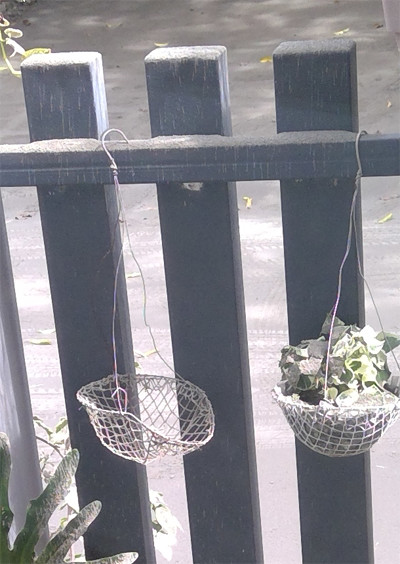
Like Mad Max, but gray
Many schools and local businesses were still closed, so we spent almost all our time at home. I tried my best to stay productive, but I found myself visiting Youtube and Reddit again.
Before I had made much more progress, the Philippine government declared a nation-wide quarantine on March 16. Any hope of returning to a regular routine was gone.
In April, I received a call from my dad. In plain language, he told me their finances weren't looking so good, and I wasn't helping. My parents wouldn't be able to support me for much longer.
I couldn't complete the game. I had only completed 6 out of the planned 13 chapters.
One thing I learned during the previous highly productive year is "Use what you got, and lower your expectations". I only had half the game I wanted... but it was still a game, one that I had poured almost 6 years of my life into making. It had around 2 - 3 hours of content. A really skilled player could complete it in 1.5 hours.
There was a way to launch this thing. I made modifications to the prologue and chapter 6 to tie everything together and make the game feel like a complete experience, like a short story. I would sell the game for less. 8 USD instead of the planned 15 - 20 USD.
Steam had announced that they were doing a Summer Game Festival from June 9 - 14. I signed us up for it, thinking we could use the festival to create awareness for the game and gather wishlists before launch. We set our launch date to June 15, the day after the festival.
The rest of April and May was a frantic effort to squash all the bugs and get the game ready for release. There are problems you find only when you sit down and do a full play-through of the game, and these take a long time to fix because you have to do play-through after play-through to confirm that the problems are gone.
John, who never stopped working on the game's audio and who had been patiently putting up with my lack of progress the entire time, got to work recording, editing, and composing this amazing trailer:
On June 1, we released the trailer and sent out emails and press review copies to Youtubers and both foreign and local games media.
One June 6, 3 days before the event, Steam announced that they would be moving the festival to June 16 - 22, after our release date. We had already publicized the release date. I couldn't move it so close to the date itself.
I contacted Steam support, asking if our game would still be included because the festival application process specifically stated that the festival was for upcoming games only - games that would be released after the festival. This was their response:
Hi Nico,
Thanks for reaching out.
The Steam Game Festival's focus is on showcasing demos for upcoming games and it 's only meant to showcase games coming out after the festival. Apologizes for inconvenience. We can help and update the release dates for your base app and demo. Let us know -- happy to help!
Cheers,
[REDACTED]
Well, they didn't specifically say that they would remove our game if we didn't change our release date. For a while I was considering launching the game on the 15th as planned, and doing nothing to prevent the game from showing up in the festival anyway because knowing Steam, the whole thing was probably automated.
In the end, I thought it best not to have any potential conflict with the hand I was hoping would feed me, and asked them to remove our game from the Festival.
We launched on the 15th with less than 300 wishlists.

Our eldest pressed the button
Today is June 24, a week after launch. We've sold 200 copies.
I know every article about game marketing out there says to gather wishlists before launch, and that your launch week is when you will make the majority of your sales, and that you have one chance or you'll blow it.
Well, we blew it.
But this isn’t the first disastrous launch we’ve recovered from. In times of crises, all you can do is focus on solving one problem at a time.
When we launched Solarmax 2, the problem was the game’s difficulty and controls.
This time, I know we’ve made a good game. Out of 200 sales, we have 20 reviews with a 95% positive rating. So far, we’ve only had 23,000 people visit our steam page. Our problem this time is visibility. I believe it’s a solvable problem.
I know of course that a good game doesn't guarantee financial success, but I also know that if I stop trying to build awareness for the game, then I will truly have failed.
I don't know anything else beyond that.
After 10 years as a game developer, I still feel like I'm starting from scratch.
Final Thoughts
When I started writing this, I thought it would take less than a day. 7 days and 8500+ words later, I present it to you. Turns out I’m still terrible at judging how long something will take. It was harder and more emotionally draining than I thought to compress the last 10 years of my life into an internet-digestible article.
I am still passionate about making games. Next to my family, it is the greatest source of joy in my life. Games have always made me feel like I could be more than I am, and that I can tackle the hardest challenges with enough time, skill, and persistence. The past couple of years have been extremely tough, but I don’t think I will ever stop trying to make games.
If you’ve read this all the way to the end, I am honestly, truly, grateful. Thank you for letting me share my story with you.
It’s not much, but I’ve packaged up all the little games and prototypes I’ve worked on into a zip file for you to download. Most are SWF files, which requires the standalone version of Flash Player to run. Adobe is killing off the Flash Player on December 31, 2020, but you can still get the standalone player here.
Scroll down to the downloads and click on “Download the Flash Player projector”.
Download Nico’s Flash Games (needs Flash Player projector) - 53 MB
Download Nico’s Free Desktop Games (Windows only) - 127 MB
Visit Lithium City's Steam Page
Thank you again, and see you in another 10 years!